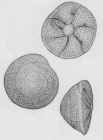Foraminifera taxon details
Rotorbinella colliculus Bandy, 1944 †
761560 (urn:lsid:marinespecies.org:taxname:761560)
accepted
Species
marine, brackish, fresh, terrestrial
fossil only
Bandy, O. L. (1944). Eocene Foraminifera from Cape Blanco, Oregon. <em>Journal of Paleontology.</em> 18 (4): 366-377. [details] Available for editors  [request]
[request]
Hayward, B.W.; Le Coze, F.; Vachard, D.; Gross, O. (2024). World Foraminifera Database. Rotorbinella colliculus Bandy, 1944 †. Accessed at: https://www.marinespecies.org/foraminifera/aphia.php?p=taxdetails&id=761560 on 2024-04-25
Date
action
by
original description
Bandy, O. L. (1944). Eocene Foraminifera from Cape Blanco, Oregon. <em>Journal of Paleontology.</em> 18 (4): 366-377. [details] Available for editors  [request]
[request]
additional source Hottinger, L. (2014). Paleogene larger Rotaliid Foraminifera from the Western and Central Neotethys. <em>Springer, Berlin.</em> 191 p., available online at https://doi.org/10.1007/978-3-319-02853-8 [details] Available for editors [request]
[request]
additional source Hottinger, L. (2014). Paleogene larger Rotaliid Foraminifera from the Western and Central Neotethys. <em>Springer, Berlin.</em> 191 p., available online at https://doi.org/10.1007/978-3-319-02853-8 [details] Available for editors
From editor or global species database
Diagnosis Rotaliidae with a single, undivided umbilical pile. Ventral intraseptal interlocular space undivided. Shoulders framing the intraseptal space without feathering. Umbilical interlocular space comparatively wide, forming a spiral canal. Species of Rotorbinella represent the phylogenetic root of the rotaliid family reaching back to Cenomanian ages. They exhibit the simplest architecture within the family. They are no K-strategists by the lack of an adult dimorphism of generations, the absence of particular ornaments on their face and by their small overall shell size remaining below 1 mm in equatorial diameter. Accordingly they are often found on or in soft substrates rich in clay minerals. [details]Original description Test subcircular in side view, hemispherical in edge view, slightly convex ventrally, strongly convex or domed dorsally; edge sharply rounded; periphery smooth or very slightly lobulate with wide nonperforate margin but no keel; chambers 6 in final whorl, increasing very gradually in size as added, uninflated dorsally, closely appressed, ventral chambers slightly inflated; dorsal spire clearly seen except early portion which is partially obscured by secondary thickening; only last whorl visible ventrally; strong umbilical plug composed of clear shell material; dorsal sutures gently curved, somewhat oblique, strongly limbate, flush with surface; ventral sutures gently curved, slightly depressed, deepening toward umbo, with small reentrant; wall thick, very coarsely perforate both dorsally and ventrally; aperture a slit at base of septal face between periphery and umbilical plug, widest toward periphery. Diameter 0.46 by 0.43 mm., thickness 0.28 mm. Very common. [details]
